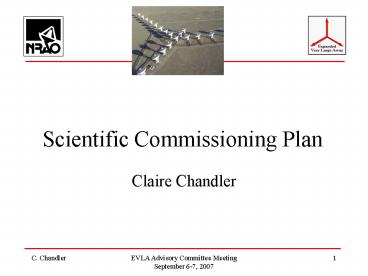EVLA Advisory Committee Meeting - PowerPoint PPT Presentation
Title:
EVLA Advisory Committee Meeting
Description:
Special modes will require experts from NRAO and the outside community to ... Early Science ... experts to help with the correlator commissioning with a call ... – PowerPoint PPT presentation
Number of Views:35
Avg rating:3.0/5.0
Title: EVLA Advisory Committee Meeting
1
Scientific Commissioning Plan
- Claire Chandler
2
Scientific Commissioning Overview
- EVLA antennas undergo Electronics acceptance
tests and Operations acceptance tests and are
then added to the array for astronomy - There are two levels of commissioning carried out
by scientific staff - Scientific staff work closely with electronics,
hardware, and software personnel to verify that
new antennas added to the array produce valid
data these tests are led by Rick Perley
3
Staffing of EVLA commissioning effort
- FTE breakdown of Scientific Services for 2008
(note does not include Rick Perley, or
scientists in EVLA computing)
4
Scientific Commissioning and Performance
Evaluation Tests
- Evaluation of antenna, receiver, and system
performance to establish whether the requirements
specified in the Project Book have been met - These tests have not yet started
- One commissioning postdoc (Brigette Hesman) began
end of FY07, one assistant scientist (Emmanuel
Momjian) starts in November 2007 to lead the
performance evaluations, one assistant scientist
currently under offer with a start date in 2009
for scientific commissioning of the correlator
5
Project Book Requirements
- The Project Book specifies target performances
for - Pointing (blind and referenced)
- Accuracy of collimation offsets
- Tracking stability
- Subreflector positioning
- Antenna slew and settle time
- Antenna electrical performance (efficiencies,
shapes, feed alignment, squint) - Tsys and overall sensitivity in each receiver
- Complex gain stability of each receiver
- Linearity of power gain
- Cross-polarization response
- Bandpass amplitude and phase stability
- Bandpass amplitude and phase structure
6
Performance Tests
- Tests for each of the Requirements have been
outlined in a memo from October 2005 (Chandler,
Carilli, Perley) but not yet implemented - The commissioning postdoc and assistant scientist
will be developing these tests beginning October
1, 2007 - Many of the antenna performance tests will be
handed to VLA Operations Division to be included
in standard start-up procedures - Others of these tests (such as bandpass stability
and shape) will require the correlator, or at
least the prototype correlator, before they can
be carried out
7
Performance Tests, cont.
- Pointing (blind and referenced)
- Accuracy of collimation offsets
- Tracking stability
- Subreflector positioning
- Antenna slew and settle time
- Antenna electrical performance (efficiencies,
shapes, feed alignment, squint) - Tsys and overall sensitivity in each receiver
- Complex gain stability of each receiver
- Linearity of power gain
- Cross-polarization response
- Bandpass amplitude and phase stability
- Bandpass amplitude and phase structure
To be handed to Operations
Require WIDAR correlator
8
Correlator Commissioning
- On-the-sky tests for the prototype correlator are
scheduled to begin Q3 2008 - Carried out in parallel with system integration
- Coincides with the move to D configuration
- We are considering extending D config. as needed
to ensure sufficient time for the correlator
on-the-sky tests - We are considering other adjustments to the
configurations to accommodate commissioning - Current FTEs allocated to testing of electronics,
etc., will transfer to correlator as needed in
2008
9
Correlator Commissioning
- After acceptance of the prototype hardware basic
correlator set-ups will be commissioned by NRAO
staff - a continuum mode with full polarization to
cover the full bandwidth of each receiver with
the minimum number of channels - a spectral line mode for observations of
multiple lines within a band - Galactic
- Extra-galactic
10
Correlator Commissioning
- Special modes will require experts from NRAO and
the outside community to commission, e.g. - pulsar gating
- Solar observing
- high time resolution
- fast switching between correlator set-ups
- Timescales
- On-the-sky tests of the prototype, Q3 2008 to Q4
2008 - Commissioning of basic modes, Q1 2009 to Q3 2009
- Commissioning of special modes, Q4 2009 to Q4 2010
11
Commissioning and Early Science
- A 10-station, 1.5 GHz bandwidth prototype
correlator is already 30 more sensitive for
continuum observations than the full VLA - The EVLA becomes very attractive for early
science opportunities - Combine the need for external experts to help
with the correlator commissioning with a call for
early science
12
Resident Shared-Risk Observing
2008
2009 2010
- Timeline (including proposal call) is tied to the
acceptance of the correlator hardware
Q3 Q4 Q1 Q2
Q3 Q4 Q1
Prototype acceptance tests
Basic science modes commissioned
Special science modes commissioned
Call for resident shared-risk observing
proposals
Shared-risk observing begins
13
Preliminary rules
- Observing time will be allocated based on
- excellence of proposed science
- ability of science to highlight capabilities of
EVLA - residence of an expert team member for a minimum
of 3 months to help with commissioning - students are welcome, but we need experienced
radio astronomers - Details of how NRAO staff can be part of this
proposal call have yet to be defined - The SAGE committee will be assisting with
defining further the rules for this call































